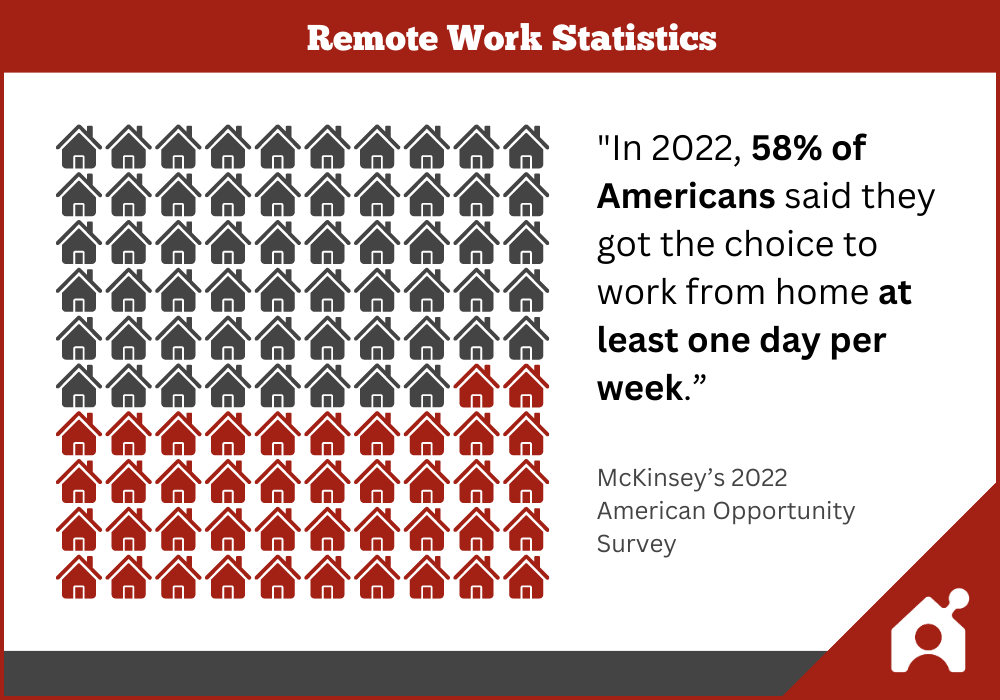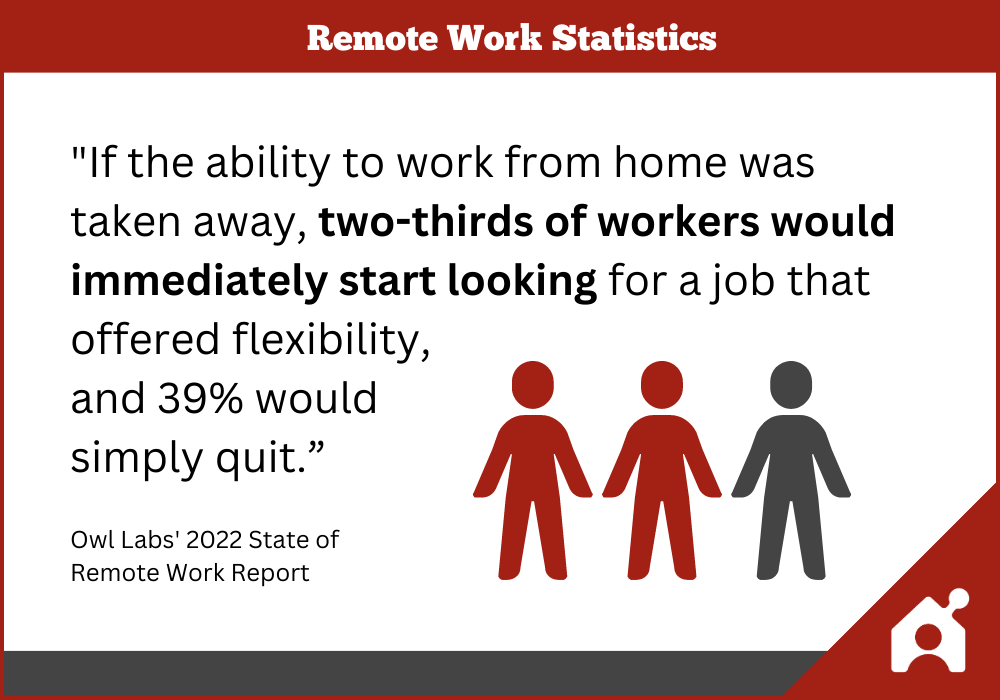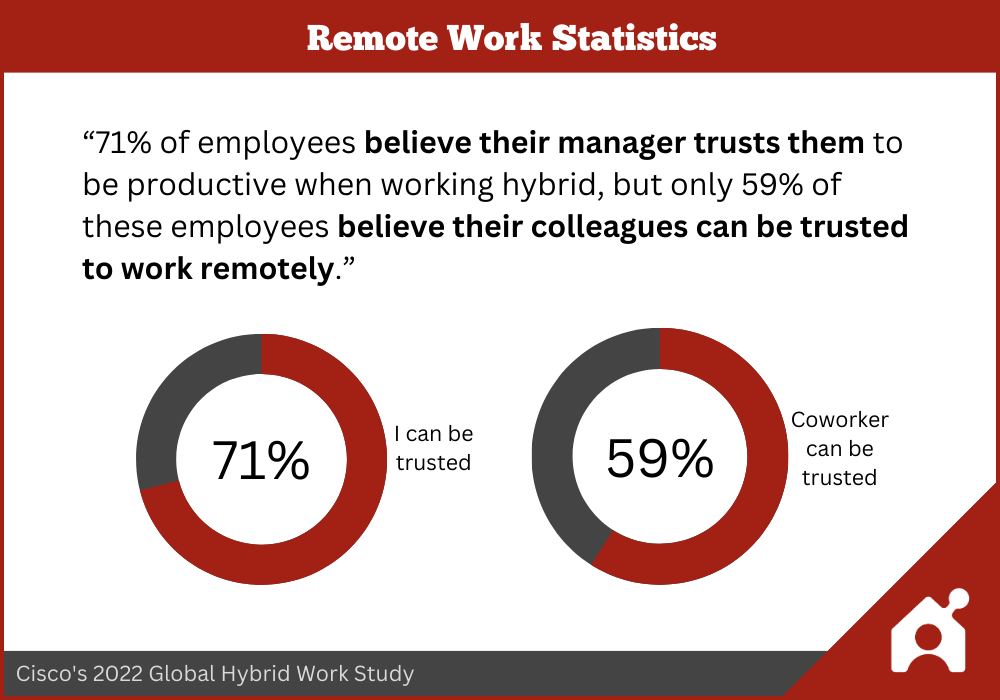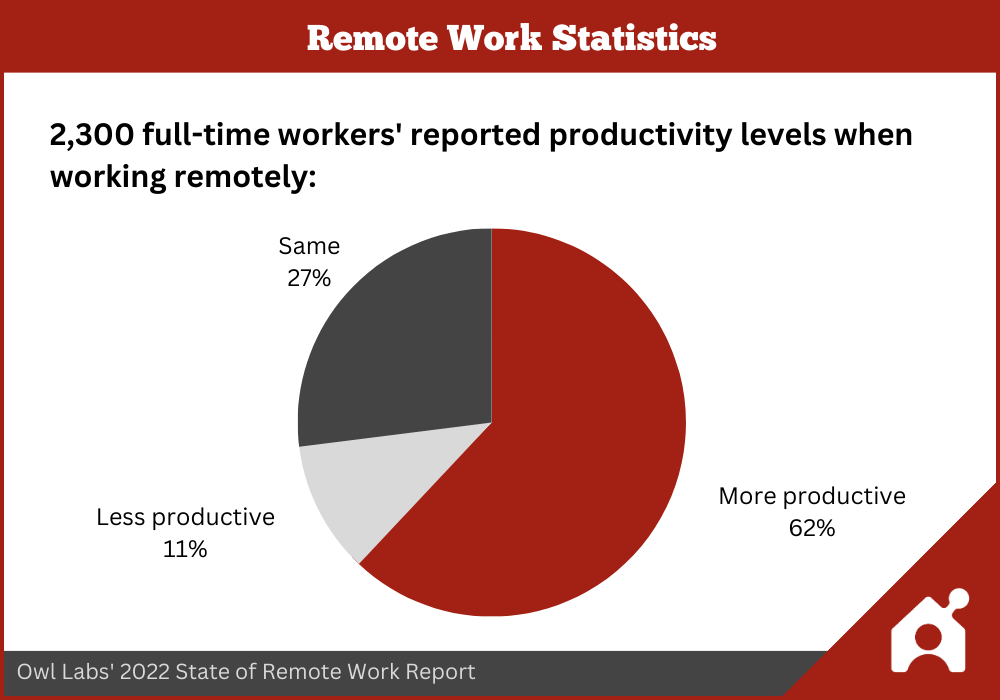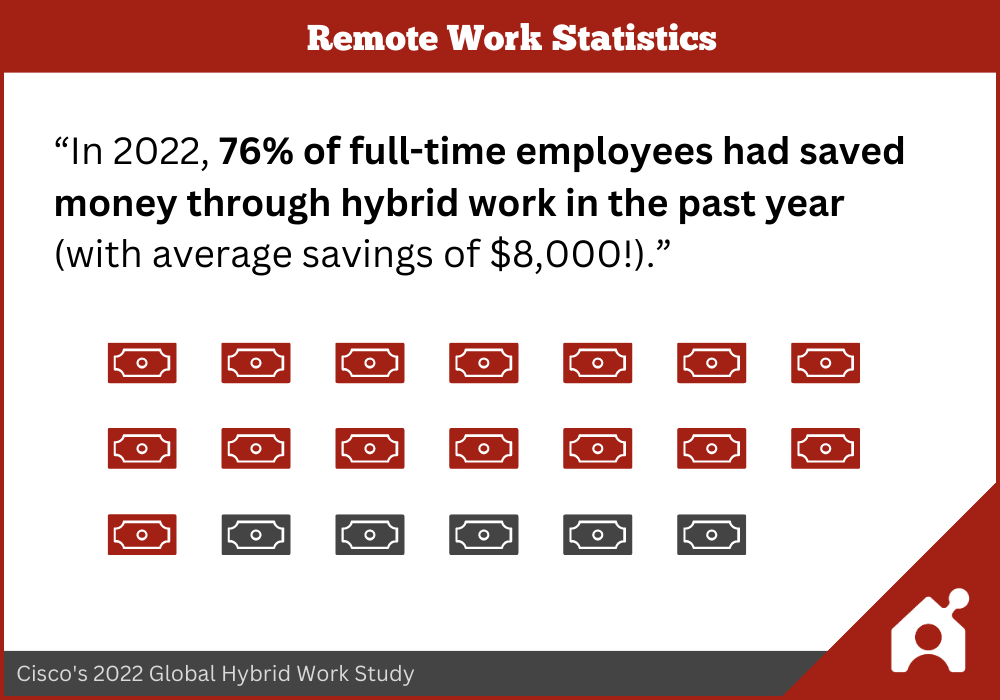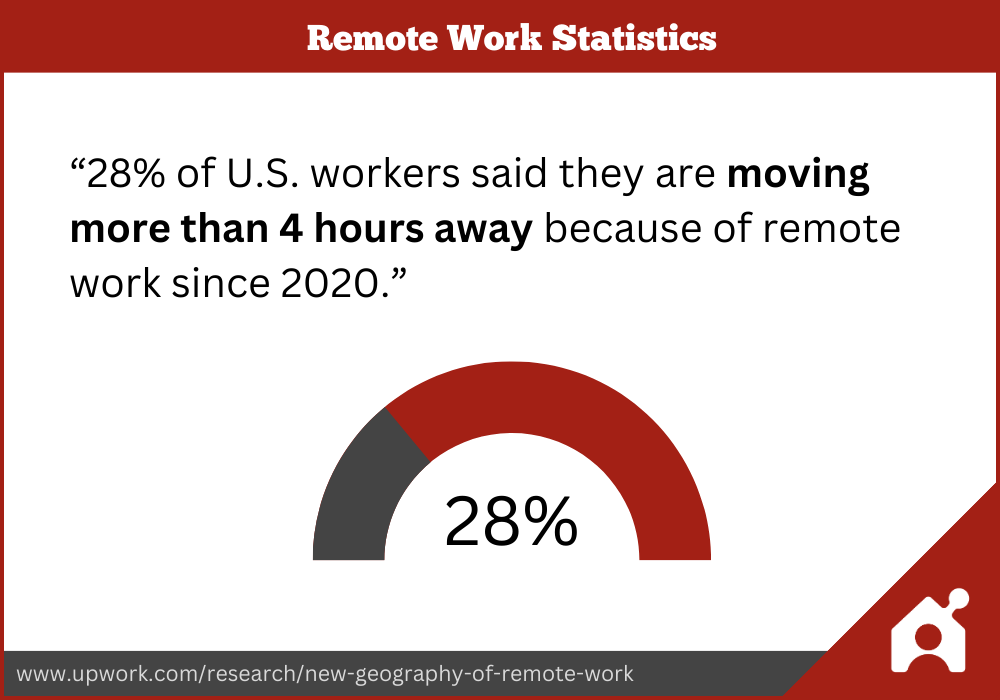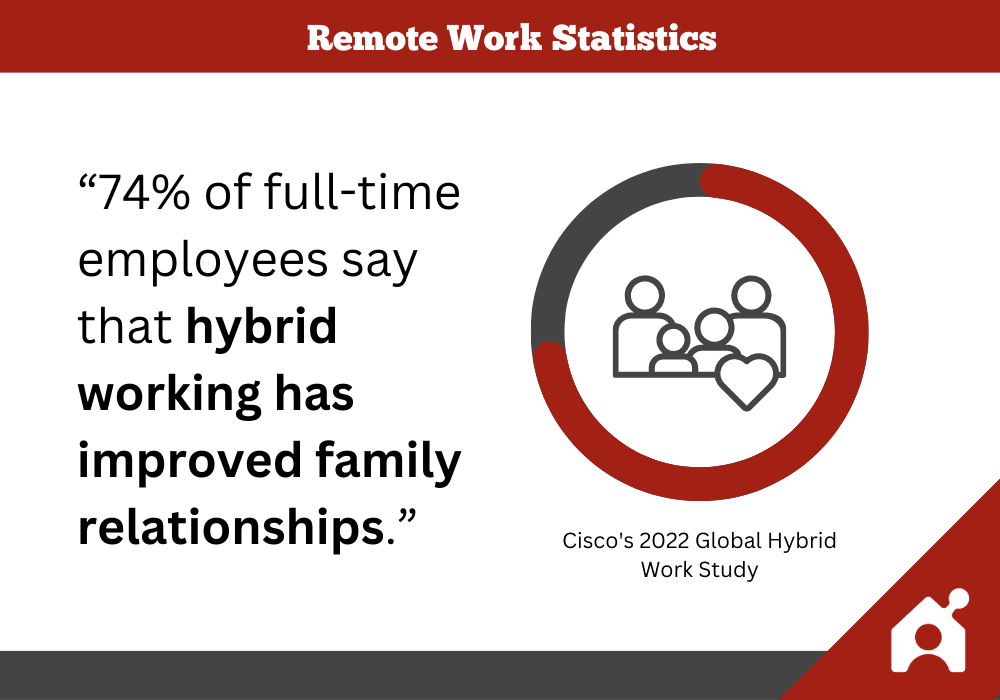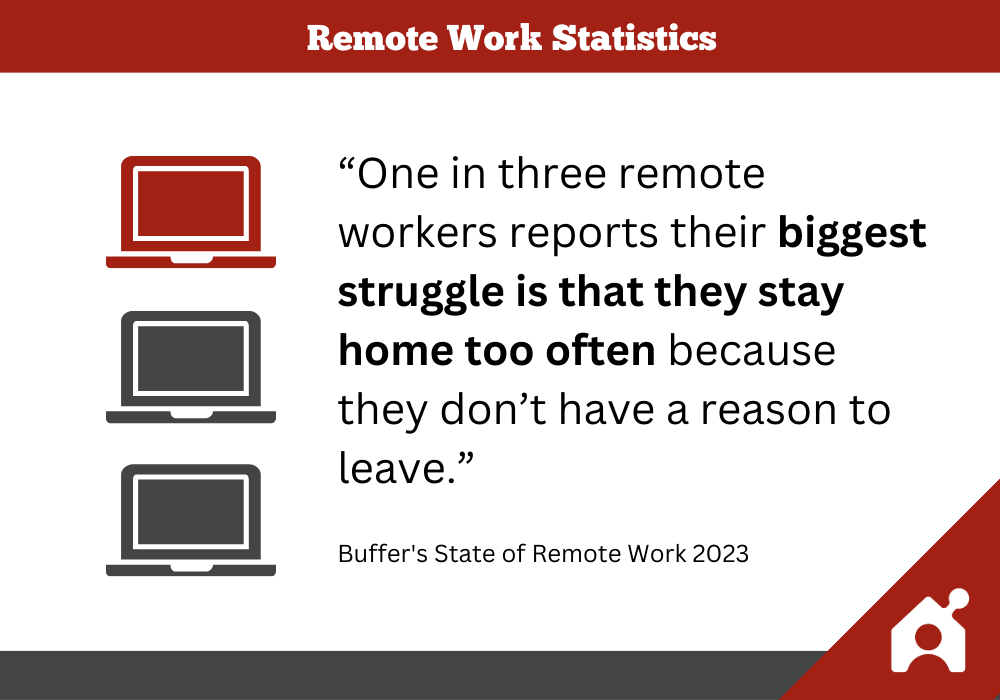43 Mind-Blowing Remote Work Statistics (2023 Update)

During the pandemic, many people thought remote work was a blip on the radar, a necessity until work could go back to “business as usual.”
But then something interesting happened. People discovered they liked working remotely! They discovered the flexibility, health benefits, and cost savings remote work provided.
Now we’re in 2023, and statistics are still showing an upward trend. Remote work is not going away. Employees want the chance to find work-life balance and reap the benefits of working from home. Companies are responding, with almost three out of four companies updating policies to include remote work as an option.
In this post, we’ve compiled 43 of the most interesting remote work statistics that have come up in the last two years.
While you should take each one of these statistics with a grain of salt (after all, they come from studies with different demographics and sample sizes), they illuminate the fast growth of remote work and the challenges companies will be facing as they integrate remote work into their company culture.
Let’s get to the numbers…
Remote Work Statistics: The Living List
We’ve divided the following statistics into sections based on different aspects of working remotely. You can read in order or skip ahead to the section you’re interested in:
- Remote Work Options
- Company Culture
- Productivity
- Well-Being
- Work Schedule
- Work Location
- Work-Life Balance
- Remote Work Challenges
Statistics About Remote Work Options
These statistics highlight the growth of remote work both in the U.S. and across the globe – both what employees are asking for and what companies are providing:
“72% (up from 46% in 2021) of remote workers who now work remotely due to the pandemic say their company is planning on permanently allowing some amount of remote work in the future.”
The takeaway for remote work:
This 2023 survey of 3,000 worldwide remote workers shows an astounding jump in companies embracing remote work beyond quarantine. In the past couple of years, it was hard to know how many companies would continue remote work once the Covid-19 pandemic was under control. Now we have enough data to prove that companies are planning on utilizing remote work for the long haul. Even if companies are not planning on offering their employees the option of working 100% remotely, it’s clear that companies are curious about the benefits of remote work and want to test results.
“In 2022, 58% of Americans said they got the choice to work from home at least one day per week.”
The takeaway for remote work:
For context, this stat is from a recent survey of over 25,000 U.S. adults, regardless of what kind of field they work in. More than half of the respondents sharing that they have the option to work from home at least once a week, and we predict that number will only go up. Employers are starting to discover that remote work can improve employee happiness.
“65% of professionals prefer a 100% remote work arrangement.”
The takeaway for remote work:
This data is from a survey of 4,000 professionals, and it highlights that remote work is here to stay. Because FlexJobs is a job search website, the participants in the survey are likely to be interested in finding a new job. With that fact in mind, this statistic shows that almost seven in ten professionals would like to work away from the office.
“The number of U.S. workers choosing to work remotely in 2022 increased 24% since 2021, and those choosing hybrid work increased 16%.”
“In 2022, U.S. workers’ interest in in-office work dropped by 24% compared to 2021.”
The takeaway for remote work:
Full-time U.S. employees are starting to experience the flexibility and productivity that remote or hybrid work can offer, and they want more of it. Not only are they getting time back in their schedule, but they’re realizing greater productivity. Plus, working away from the office can save money, about $19 a day for hybrid workers working from home. No wonder they’re losing interest in going back to the office.
“If the ability to work from home was taken away, two-thirds (66%) of workers would immediately start looking for a job that offered flexibility, and 39% would simply quit.”
The takeaway for remote work:
Employers need to figure out how to make remote work viable in the long term because employees are embracing it. Companies can’t afford to go back to fully in-office; they may lose key individuals who have discovered the efficiency of remote work.
“Fully flexible companies increased headcount by 5.6% over the last 12 months, compared to 2.6% for full-time in-office companies.”
The takeaway for remote work:
This report by Flex Index and People Data Labs shows that the number of days companies require employees to come into the office is negatively correlated to the number of employees they draw in. In other words, companies offering remote work are getting more talent.
Statistics About Remote Company Culture
These statistics show how companies view remote work and what employees think about their views:
“62% of global remote workers work directly with teammates across multiple time zones.”
The takeaway for remote work:
Remote work has enabled companies to reach outside the boundaries of their town or state. This means companies can find better talent (because they now have access to global individuals). But hiring employees in different time zones also comes with challenges, such as finding the best times for meetings and knowing when to communicate. Companies may need to rethink their processes to make sure they’re getting the benefits of multi-time-zone talent.
“Only 38% of remote workers worldwide say their company has an async-first policy.”
The asynchronous approach (often called async work) focuses on communicating through channels that aren’t time-based. Async work utilizes focused, independent work and communication through methods that allow employees to choose when they interact with new information. Instead of expecting employees in different time zones to drop everything when a work message comes through, the async approach encourages employees to set their own timetables so that their work can be uninterrupted. This creates a more efficient, productive team since workers can work independently of each other.
It’s surprising that only about a third of companies are embracing async work as a solution to time-zone barriers. As more and more companies discover the benefits of remote work, we predict that asynchronous work will start to pick up. After all, trying to force a time-based approach on employees working in multiple time zones can impact productivity and slow down projects.
“71% of full-time employees believe their manager trusts them to be productive when working hybrid, but only 59% of these employees believe their colleagues can be trusted to work remotely.”
The takeaway for remote work:
While the statistic that more than two-thirds of employees feel trusted by managers to work partly remotely is encouraging, the fact that only about half of employees trust their colleagues to do the same shows that company culture still has a ways to go. If people trust themselves to be productive at home (as the Productivity section of this article shows), the takeaway may be that many workplace cultures still doubt the validity of working from home. The leaders set the tone of the company’s culture, so this may imply that while employees know they will do a good job working remotely, they may be picking up on management’s doubts that employees will produce results away from the office.
“41% of small companies (10-50 employees) are requiring employees to return to the office compared to 27% of enterprises (10k+ employees).”
The takeaway for remote work:
This Owl Labs study surveyed 2,300 full-time workers in the U.S. The data has interesting implications. While small companies may not have the capacity or the processes in place to continue remote work beyond the pandemic, it’s clear that enterprises are discovering the efficiency and productivity remote work provides. As such large companies, many enterprises already have employees in multiple time zones or countries, so it’s easier to see the advantage of utilizing remote work. Larger companies may also have better processes enacted to allow remote work to continue, such as policies for online communication and applications for video calls and chat.
“73% of full-time employees believe companies need to rethink culture and mindset to make hybrid work truly inclusive.”
The takeaway for remote work:
This Cisco survey of 28,000 full-time employees around the world revealed that while remote and hybrid work are improving company culture and employee well-being, employees still believe their companies can improve. Intentional changes to schedule policies can help. After all, better flexibility and work-life alignment are employees’ most sought-after improvements from remote work.
Statistics About Remote Productivity
These statistics look at how both employers and employees feel about remote work and its impact on employee output:
“73% of full-time employees say the ability to work hybrid has made them happier and more motivated in their role.”
The takeaway for remote work:
This stat is impressive because it’s taken from a Cisco study of over 28,000 full-time workers across the globe. Clearly, having the option to work remotely, even just some of the time, is important to almost three out of four employees. That’s huge. It indicates what an important role remote work is going to have in hiring and employee retention moving forward.
“76% of full-time employees feel their role could be performed just as successfully remotely as in the office.”
“Two-thirds (62%) of workers feel more productive when working remotely, while just 11% feel less productive. Millennials feel the most productive while working from home (66%), and Boomers feel the least (46%).”
The takeaway for remote work:
These stats show that employees feel they do their best work when they’re allowed to work where they want. This is especially true for younger generations, while older generations may feel less productive working remotely. The takeaway is two-fold:
- Companies can gain a lot from offering remote work. If employees feel more productive outside of the office (and they are reporting this to be true), companies have much to gain from offering some form of remote work.
- Companies will need to ensure all employees (including those who don’t feel as productive working remotely) feel like they have the support they need to get work done outside of the office. This means companies will need to encourage open communication and have the right people accessible so remote employees can ask questions.
Research shows that the majority of hybrid employees feel they work better remotely for tasks like creative thinking and independent work, so it’s crucial that companies take the time to create remote policies so employees can work to their full potential.
Well-Being Statistics
These statistics link remote work with employee health and well-being, and the numbers are encouraging:
“86% of full-time U.S. workers said being able to work from home – at least some of the time – would make them happier.”
The takeaway for remote work:
Companies looking to increase employee retention should pay attention; this statistic clearly shows what employees would like. If companies want to keep employees invested in the company, they need to provide the flexibility employees are looking for.
“78% of full-time employees believe that hybrid and remote working has improved their overall well-being.”
The takeaway for remote work:
Since this statistic is from a survey of 28,000 full-time employees in markets all over the world, it’s a solid representation of employees’ views of remote work. Three out of four full-time employees feel healthier and happier working away from the office at least some of the time. If this isn’t an attention-getter for companies still on the fence, we don’t know what is.
“In 2022, 76% of full-time employees had saved money through hybrid work in the past year (with average savings of $8,000!).”
“68% of full-time employees believe hybrid working has had a positive impact on their physical fitness.”
“77% of professionals think having a remote or hybrid job has or would help them manage their mental health issues.”
The takeaway for remote work:
As more and more employees discover the benefits that remote work offers, they’ll want jobs that give them this opportunity. For companies to stay competitive, remote work can’t be ignored. Working remotely helps employees feel more in control of their time, their relationships, and their health. If companies want a workforce that is happy (and therefore more inclined to stick around), they’ll need to get on board with remote work as a long-term approach.
“75% of remote workers feel connected to their colleagues (even those in different time zones).”
The takeaway for remote work:
This statistic helps to show that even working remotely can foster good relationships within a company when done well. Since this statistic is from a Buffer study on the state of remote work, it’s good to keep in mind that the people answering the questions all work remotely. That being said, three in four remote workers feel they are connected with other remote coworkers. This is a huge deal because it points out that remote work can have a social side.
Work Schedule Statistics
These statistics show how many workers are fully remote and how much time remote workers are spending in meetings:
“Approximately 35% of U.S. employees work remotely all the time.”
The takeaway for remote work:
For context, before the pandemic, the percentage of employees who could and did work remotely was only 7%. Of course, the numbers spiked during Covid-19, but this change from 7% to 35% in only four years is incredible, showing just how quickly businesses can shift to an online environment.
“75% of remote workers spend 1-10 hours of the work week in meetings.”
The takeaway for remote work:
For companies looking to get the most out of remote work, it’s important to remember that less is more. The more meetings, the less time employees have to get meaningful work done. Requiring all employees to meet at the same time can be a challenge for workers in different time zones (which is part of the reason companies are turning to async work). However, meetings can be a great way to make sure everyone is on the same page and to learn about any roadblocks that have come up. This stat shows that three in four remote workers are still being asked to meet synchronously throughout the week, an interesting look into the schedules still embraced by many companies.
Work Location Statistics
These statistics highlight how heavily remote work has impacted travel and moves:
“Two-thirds of organizations surveyed say they allow domestic remote work, but 45% say they limit the amount of time employees can work outside of their home state.”
“Millennials are interested in work-from-anywhere policies more so than Gen Z workers (81% of Millennials to 66% of Gen Z).”
The takeaway for remote work:
These stats show that while companies may be experimenting with remote work policies, many still have fixed views of where remote work should take place. While this may not be an issue for many workers (who only want to work from home anyway), research shows that Millennials in particular are hoping for policies that let them work remotely from anywhere. For companies looking to draw in talent, it might be time to reconsider the purpose of limiting remote work to a specific area. As long as the results are there, does it matter if the employee is at home or in Peru?
“52% of U.S. workers would take a pay cut of 5% or more to have flexibility in working location, with 23% saying they would take a pay cut of 10% or more.”
“2.4% (4.9 million) U.S. workers say that they have already moved because of remote work since 2020.”
“28% of U.S. workers said they are moving more than 4 hours away because of remote work since 2020.”
The takeaway for remote work:
These statistics point out two things. First, U.S. workers are embracing remote work as a way to gain control of their lives. They have discovered the flexibility remote work offers, and they are taking full advantage of it to find new ways to live. Second, because employees are embracing remote work policies so fully, companies need to have a game plan for remote work. They can’t treat remote work like a fad. There is no going back – employees want jobs that offer flexibility, and they’re willing to quit if their company stops allowing remote work.
Work-Life Balance Statistics
These statistics show how employees feel about remote work and how it looks day-to-day:
“79% of full-time employees feel that working away from the office improved their work-life balance.”
The takeaway for remote work:
Even with the challenges of remote work, almost eight in ten employees (from a sample of 28,000 full-time employees worldwide) still feel that remote work helps balance work and life. Companies looking to increase employee happiness and retention should consider the benefits of remote work. After all, if employees feel balanced and healthy, they’ll be more productive when it’s time to get to work.
“74% of full-time employees say that hybrid working has improved family relationships.”
“44% of full-time employees reinvested time savings from remote work into time with family, friends, and pets.”
The takeaway for remote work:
There are always challenges to working remotely, especially for employees with kids or elderly parents to take care of. But overall, research has shown that employees who are allowed to work from home report stronger relationships and increased happiness. This work-life balance is a wonderful perk of working from home, and it can spill over into better productivity at work, too. Some employers may be worried that employees at home won’t be able to focus because they’ll be surrounded by family members and distractions. While this is a valid concern (after all, 77% of those who feel less productive at home say it is because of distractions), improved family relationships seem to be one of the main contributors to employee happiness with remote work overall. In other words, although family may cause distractions every once and a while, better relationships are one of the biggest reasons employees are loving (and thriving in!) the remote work environment.
“63% of 4,000 professionals stated they would choose better work-life balance over better pay.”
“62% of full-time employees agree that the ability to work remotely has made them less likely to leave their jobs or look for other employment.”
“57% of professionals stated they would look for a new job if they couldn’t continue to work remotely.”
The takeaway for remote work:
Employees are ready to take lower pay to have the flexibility and freedom to balance their work and life. No wonder remote work is in high demand. Companies that don’t offer remote work may find themselves falling behind those that value remote work, as employees have made it clear they will look for opportunities elsewhere if remote work isn’t an option at their current company. While this sounds scary, the reverse is also true. Employers who offer remote work may find that their hiring pool expands and their current employees stay longer.
Remote Work Challenges
Even with all the benefits of remote work, there are bound to be some downsides. These statistics highlight the challenges companies and employees will face moving forward:
“84% of full-time employees say networking infrastructure is essential for a seamless working from home experience, but only 68% say their company currently has the right networking infrastructure now.”
The takeaway for remote work:
This statistic points out how important it is for companies to have the right tools for remote employees. If employees don’t feel supported working from home, they won’t feel as happy or productive. A bad infrastructure could make remote work an issue instead of a benefit, so companies need to make sure they have processes set up to prevent this.
“One in three remote workers reports their biggest struggle is that they stay home too often because they don’t have a reason to leave.”
“53% of those who work from home at least some of the time say working from home hurts their ability to feel connected with co-workers, while 37% say it neither helps nor hurts. Only 10% say it helps them feel connected.”
“23% of remote workers selected loneliness as the biggest struggle for remote workers.”
The takeaway for remote work:
While remote work has many upsides (like increased employee happiness and wellness), loneliness is an obvious problem. Since workers usually work from home, they may feel isolated or unable to connect with their coworkers. Companies can help alleviate this issue by creating opportunities for remote employees to connect. Message boards like Slack can provide a place for remote workers to share how their day is going. Most importantly, companies need to foster a culture that’s social. They should encourage employees to talk about subjects other than work (some companies create a special board for this) and leave time during a Zoom meeting for employees to catch up. Treating relationships as important will go a long way in helping employees feel connected.
“81% of remote workers claim to check work emails outside of work hours, including 63% who do so on weekends and 34% while on vacation.”
The takeaway for remote work:
While remote work provides amazing flexibility for workers, it can be hard to turn “work mode” off. This is a problem because it can lead to burnout and subpar results. Companies can help remote workers create balance by using an async model. At the very least, managers should make sure they’re not messaging or calling employees outside of agreed-upon work hours. The company culture should re-enforce the idea that remote work is not about working all the time, but about working intelligently.
“49% of U.S. full-time workers feel managers view those in the office as harder working and more trustworthy than their remote counterparts.”
“55% of full-time employees believe micromanaging behaviors have increased with hybrid and remote working.”
“60% of managers are still concerned that workers are less productive when working remotely, which may be why over a third (37%) of employers have added or increased the use of employee activity tracking software in the past year.”
The takeaway for remote work:
These statistics point out the trust issues that still surround remote work. For companies to reap the benefits of increased employee happiness, they’ll need to first change their culture. A culture of trust will create an environment where employees want to create results for the company. If employees feel watched and mistrusted, it will affect their performance and undermine their loyalty.
“42% of U.S. workers are concerned that working remotely will impact their career progression.”
The takeaway for remote work:
If almost half of U.S. workers are afraid they’ll miss out on opportunities because they’re “out of sight, out of mind,” this shows a problem with how U.S. companies are viewing employee output. Opportunities should be given to the employees who produce results, not the ones who stay the longest in the office.
To Wrap It All Up
It will be interesting to see how remote work trends continue to morph as companies explore what working remotely could mean for their employees and their bottom line. These statistics aren’t the end-all-be-all, but they do show just how much remote work has influenced the workplace in only a short time. With developments in Artificial Intelligence (AI) and new software all the time, we predict that remote work will continue to shift. But one thing is certain: remote work is not a passing fad. It’s here to stay.
Want to add a remote work statistic?
Like all of our articles, we view them as living resources. We want to update wherever we are missing something or have outdated information. Did you recently come across an insightful statistic about remote work? Please fill in the form on this page to let us know.

